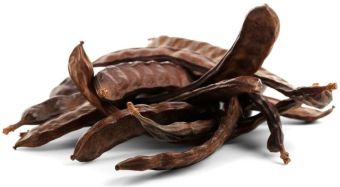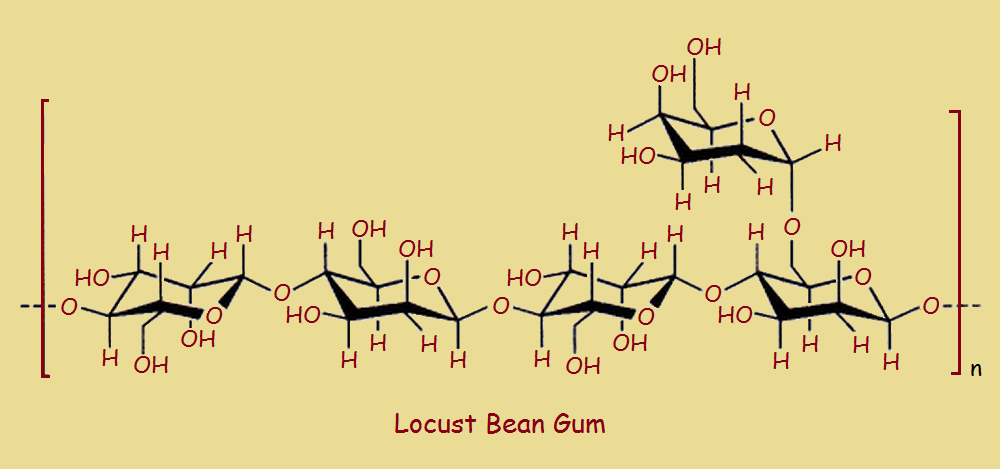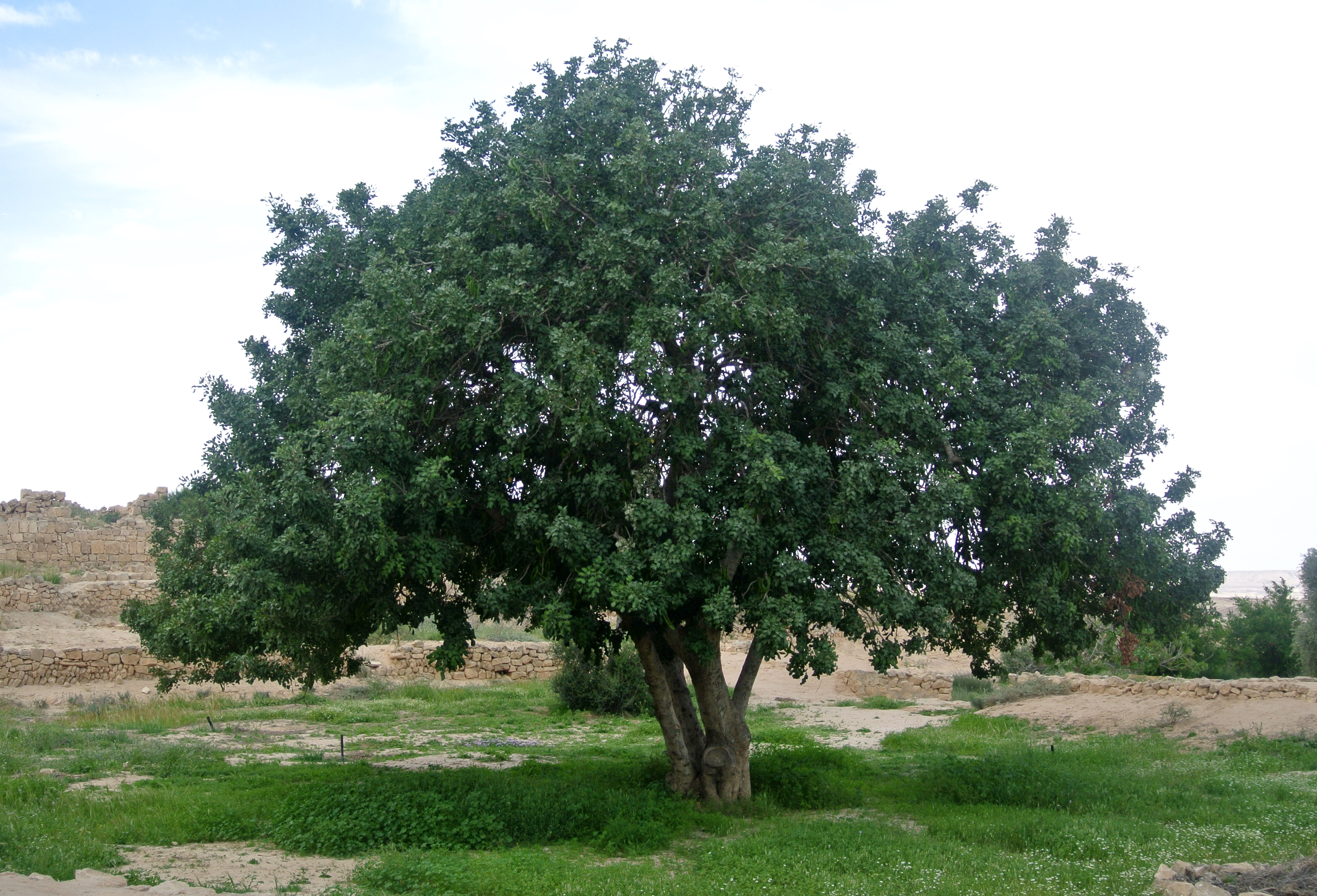 Chocolate is Man’s unquestioned favorite sweet treat. At one time, the wisdom of eating chocolate was questioned.
Chocolate is Man’s unquestioned favorite sweet treat. At one time, the wisdom of eating chocolate was questioned.
Carob was offered as a replacement, though it never caught on. Despite that, carob is of commercial importance. In fact, a derivative of carob is probably very familiar to you—locust bean gum. What is locust bean gum?
What It Is
Locust bean gum is a food additive—a thickener—derived from the carob tree (Ceratonia siliqua). It is prevalent in the region of the Mediterranean. The elongated pods of C. siliqua are coarsely ground, then separated as two fractions—pulp and seed. LBG is derived from the seed fraction.

Seed Processing
Seeds first have their skins removed by acid treatment or by roasting and mechanical removal. The seeds are then split and milled. The rugged yellowish endosperm is collected and fine-ground into “flour.” This flour can be used to form a sol. Or it can be modified to form a gel, by combining with carageenan. Although LBG is not very soluble in tepid water, it dissolves readily in hot water.

Chemistry and Structure
The chemical structure of locust bean gum consists of linked sugar units. Specifically, it is made up of two hexose (6-caron sugars), mannose and galactose, in a ratio of about 4 to 1.
The mannose units are bonded end to end with galactose units attached at the side. The LBG structure is immense, with a molecular weight of from fifty thousand to two million!
Locust Bean Gum in Food Use
Although it can be employed in a number of other applications, the most familiar use of LBG is for food. Dairy products, sauces, and salad dressings contain locust bean gum. Meat products, breads and breakfast cereals may contain it, as well. LBG can be used to replace fat, and lower cholesterol. It has even been associated with decreased diarrhea in infants.
Note: You might also enjoy What is Carageenan?
References:

Where does “locust” come from in “locust bean gum”?
Just taking a guess, but maybe because if you shake the pods they’re noisy? Like a snake rattle. I have one in my yard. Those pods are a pain when it’s time to mow. And they can have a strong smell when they’re broken.
U, you have honey locusts pods not carob in my opinion. Carob pods don’t have a strong smell.
The carob tree is in the Leguminosae family (peas and beans). It also contains the American trees black locust (Robinia psuedo-acacia) and honey locust (Gladitsia tricanthos). All three have pods that have similar seed containing structures.
It is simply another name for the tree. We often have a number of names for a single plant. To name one, the Yucca filamentosa is variably called Yucca, Adam’s Needle, Bear-grass, Spanish Bayonet, etc.
Thank you for this informative article. I was wondering what form of LBG they are using in nut milk. The bad press that carrageenan has received over the years has seen a change with some alternative milk providers using LBG instead; you mention the combining of LBG with carrageenan to form a gel, I was wondering if providers are using this form and whether, if not used in large quantities they are required to list it in ingredients.
Gerry, I believe this URL should answer your question. I can’t speak about government labeling with authority… Take special note of the difference between degraded and undegraded carageenan in the article.
Thank you for the link. There seems to be some confusion on whether carageenan in a degraded or undegraded state is safe at all. I also read that undegraded becomes degraded inside the body. I think I will stick to making my own nut milk without additives. Thank you again.
You mention that the beans have their skins removed by ‘acid treatment’, i am wondering what this ‘acid’ is, if this acid leaves any residue and is it safe for human consumption?? The thought of being roasted seems healthier!
The acid used is warmed sulfuric acid, which may affect the appearance, but should not affect the safety outcome of the product. It’s funny, though, how sometimes a word can sway our sympathies.
Whether it is Locust Bean Gum or Guar Gum, it is disgusting. I can taste the difference in my once favorite dairy products like Breyers Ice Cream and Brown Cow Yogurt that have added it to their mixture recently. It’s obviously a financial decision so they can thicken their product using cheaper ingredients than the creamy fat that comes naturally. I can taste the difference right away. The gums add a sterile faint medicinal taste to the product. Shame on the food manufacturers.
I used to buy Breyers until one day I found it tasted awful. When I read the label I discovered it no longer described itself as “all natural” and found the same to be true on all their flavors. The solution I found is to switch to Haagen-Dazs. It is more expensive but worth it. See: https://www.haagendazs.us/products/ice-cream/ Life is too short to be eating junk.
I agree that Haagen-Dazs is far superior. Unfortunately, money is at a premium for a high percentage of people. I would purchase something like their rum raisin ice cream (I slurry it with Bacardi’s golden rum) on a special occasion only. Funny thing is, I was talking about this just the other day. At one time Breyers’ was considered top-notch. But the American public is fickle and the American entrepreneur is always scheming. They could not stay on the top and had to cheapen quality.
Hi,
Thank you for posting this article. Just wanted to mention that the Oikos yogurt contains locust bean gum (so says the label in Canada). Anyway–I bought it from Costco. As you may know it has a “rich” texture, very palatable though. Now I know where it is coming from. The carob gum is E410 coded and approved under the European Safety Food Agency, however I have my reservations… It does not taste like “real” yogurt made from “real” cows’ milk. I guess I’ll stick with my kefir.
Interesting. I have eaten Oikos and yet never read the label. I suppose it’s because I was given some first, found it acceptable, and then checking never crossed my mind. I’ve never had kefir. I’ll have to look for it. Thanks for responding.
[…] was going to be risky enough, never mind testing the gelling properties of agar agar, LBG and their healthy […]
[…] was going to be risky enough, never mind testing the gelling properties of agar agar, LBG and their healthy […]
So in other words, company’s use “gums” to stretch the product for increased profit.
I’d say that wasn’t too far from the truth.
We are being fed more and more garbage as long as it’s in “small amounts.” But it’s in EVERYTHING!
Ice cream use to be made out of CREAM. Now it’s mostly bean gums. YUCK! We bought an ice cream machine for about $224.00. WOW. REAL ICE CREAM. I forgot what that tastes like. The junk they sell now? Even the high priced stuff has bean gums and corn syrup. The box it comes in has more flavor.
Bought a carton of almond milk only to find bean gum in that. Same for a can of coconut milk. WHY? I don’t believe beans are growing inside coconuts!
I have had it with this crap in my food. More and more I’ve been cooking from scratch. My daughter made real almond milk. OUT OF ALMONDS!!!! What a concept.
Too few people realize that companies keep slipping more and more of this cheap filler in their foods.
No more for me. Cooking isn’t all that difficult.
I started a pinterest board just about foods and the junk in it all now. I’ll add this page.
You’ve put into eloquent words how most of us feel. The catch is: they know the consumer is pretty much stuck with the stuff they feed him.
Only the stupid consumers. Or the ones too lazy to care. It does take time and effort to read labels. But it’s SO worth it to just put it back.
Case in point. Found a great recipe for cherry biscottis on pinterest. Only it called for maraschino cherries. Every single brand on my grocery stores shelf had the number one killer in it. High fructose corn syrup. So… I used some dried tart cherries instead. Ingredients? CHERRIES.
DANG they came out good. No bean gum, no corn syrup of any kind, no hydrogenated oils, no food colorings, and not at all hard to make.
Yup it’s scratch cooking from now on for me. Only way to really control what you put in your body.
[…] to replace packaged jelly loaded with sugar or chemical sweeteners. A couple of tea bags. A bit of LBG. This recipe was fun to create and fun to […]
Reading all the comments has really been interesting. I started out trying to find out why carob bean gum is called locust bean gum, because I am allergic to American locust trees, and I find that I get an allergic response to products containing locust bean gum, including some yogurts. Then I see that locust bean gum is the same as carob bean gum. Why is that? Apparently the 2 trees are from the same genus. The carob tree is Mediterranean. Then there is guar gum from a certain legume, also gives an allergic reaction. Could be from the peanut family or soy. Then there is the fact that sulfuric acid is used to separate the pod from the seeds. I am allergic to medications with a sulfur base. Years ago I made my own yogurt with no problems, so I have been hunting down the usual suspects. Now, for all the criticisms for using these products in yogurt: without thickeners to hold it together, yogurt would not survive shipping without the whey (protein) separating from the milk solids. Sometimes you still get that with the best locust bean gum available and if you don’t handle it carefully yourself. So there is a reason for them. I need to say, look at the ingredients and find the ones which bother you the least. And don’t take for granted that each flavor within a brand has the same formula. I have found that Brown Cow maple uses fruit pectin which comes from apples and I’m sure that under this brand they wouldn’t come from China. Trader Joe’s Greek apricot mango uses tapioca starch. I haven’t tried it yet, but Trader Joe’s is very good with ingredients. No fructose syrup!
[…] to replace packaged jelly loaded with sugar or chemical sweeteners. A couple of tea bags. A bit of LBG. This recipe was fun to create and fun to […]